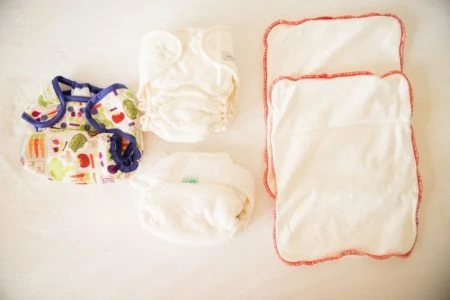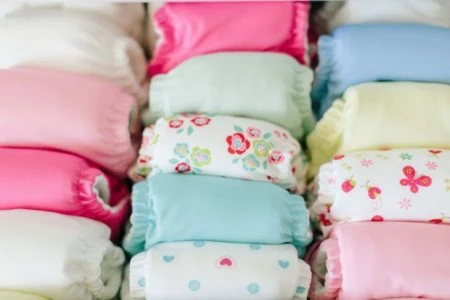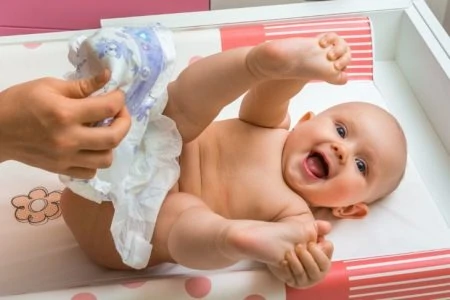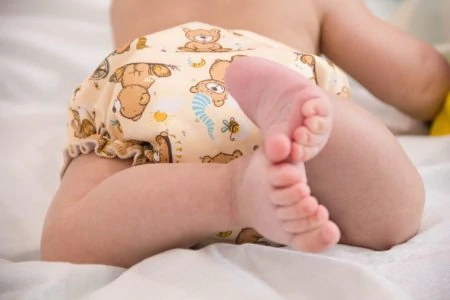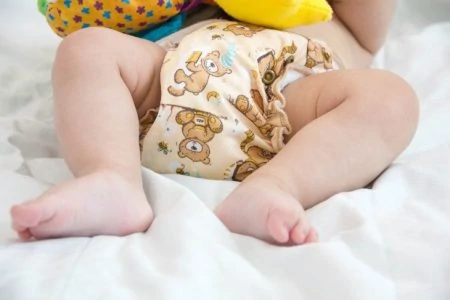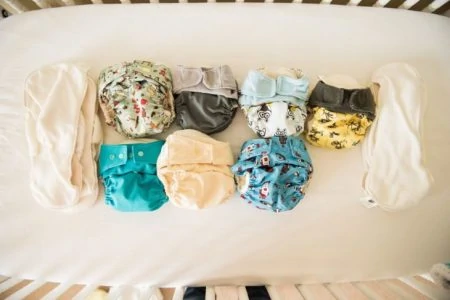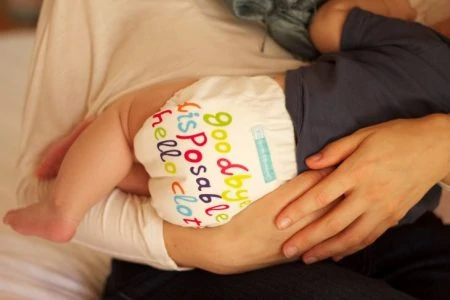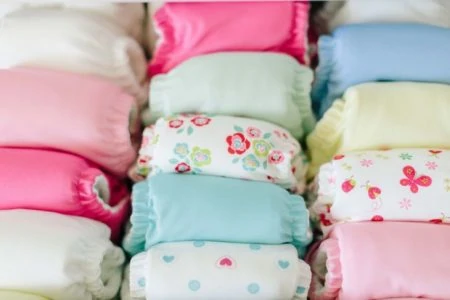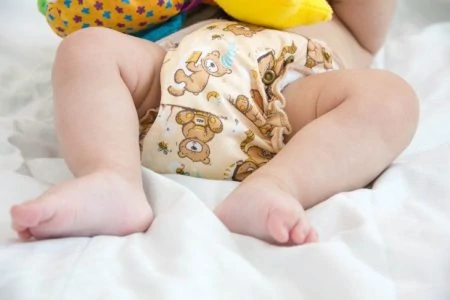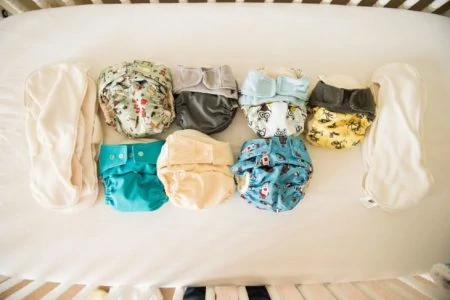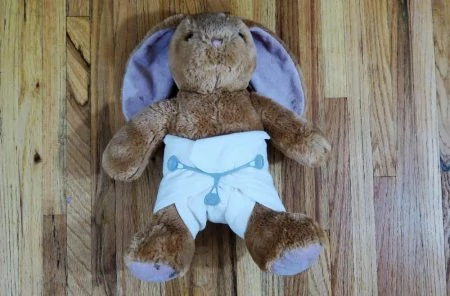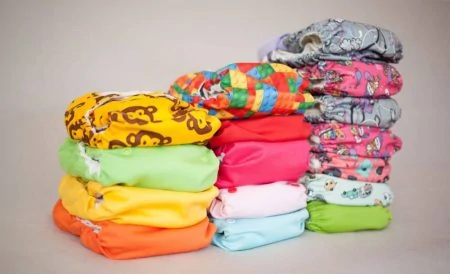Are you looking for ways to lower your carbon footprint with a baby on the way? Do you want to try cloth diapers but have no idea where to start?
If you’re worried cloth diapers are complicated and time-consuming, we’d like to show you otherwise. In our many years of cloth diapering our little ones, we’ve learned how to keep it simple. And we’ve saved thousands of dollars and kept countless diapers and wipes out of landfills.
We’ll answer all your questions and explain the cloth diapering process from start to finish to make it easy for you to make the switch.
Here’s everything you need to know about how to use cloth diapers.
Key Takeaways
- Cloth diapers save money and help the environment by reducing waste and resource consumption.
- Different types of cloth diapers include flats, prefolds, pockets, all-in-ones, and all-in-twos.
- Essential cloth diaper accessories include covers, diaper fasteners, wet bags, and cloth wipes.
- Washing cloth diapers involves a pre-wash and main wash, with attention to water hardness and detergent compatibility.
Reasons to Use Cloth Diapers
Let’s take a moment to talk about some of the reasons moms are choosing cloth diapers.
1. Cost-effective
Cloth diapering saves you a ton of money. Now don’t get me wrong, the upfront cost can look scary. Depending on what kind of cloth diapers you use, and whether you buy used or new, cloth diapers can cost anywhere from $200 to $800 at the start. Even so, you’ll save money in the long run.
If you use disposables for your baby, and your baby is potty trained right at the age of two (although most babies take longer than this), you will spend roughly $1,350 on costs related to diapering. That’s $550 total savings for using cloth diapers and wipes.
The savings get even better if you have another baby. I only spent an additional $100 to cloth diaper my youngest. That included a few more cloth wipes and some girly diapers to add to my stash. So with her, I saved a total of $1250 when it came to diapering.
2. Eco-friendly
Using cloth diapers doesn’t only help your wallet; it helps the planet too — despite what people might say. We wish we had a nickel for every time someone told us we weren’t really helping the planet since we have to wash those cloth diapers.
Did you know it takes an estimated 500 years for a disposable diaper to decompose (1)? Considering over 20 billion disposable diapers are put into our landfills every year, that poses a serious problem.
On top of that, disposable diapers account for the use of 200,000 trees a year in the United States and 3.4 billion gallons of fuel.
We wash our cloth diapers two to three times a week. The amount of water usage estimated for cloth diapering one child from birth to potty training in a high-efficiency washing machine is about 10,000 gallons. Flushing your toilet five times a day for that time would use about 60,000 gallons.
You might wonder about the amount of water used to grow the cotton and bamboo in many diapers. That’s a valid concern, and there are synthetic fiber diapers if you choose those instead.
Keep in mind that, while synthetic diapers are better than disposables, they’ll also take hundreds of years to break down in a landfill.
Different Types of Cloth Diapers
Every picture of my dad in diapers involves what looks like a towel and safety pins. I cringe every time I think about the potential of accidentally sticking my baby with one of those.
Cloth diapering has come a long way since then. Traditional cloth diapers — also called flats — still exist, but even these have been updated to make the job easier than ever.
1. Flats
Flats are the oldest and most traditional kind of cloth diapers. Flats are basically what their name says, a large flat sheet of cloth you fold up to use as a cloth diaper.
If you’re on a budget, flats are the cheapest option because you don’t even have to purchase flat diapers to create a flat. With this method, you can turn many things into a cloth diaper, including dishtowels, old sheets, receiving blankets, and flour sack towels.
If the item you find is not square, you can fold one end to make it square before doing the diaper fold.
Flats might have been what your grandmother used, but technology has come a long way to make them less complicated and more appealing to the eye.
Safety pins are no longer necessary. You can use diaper fasteners to hold the diaper together. No more worrying about sticking your baby!
The rubber pants of 50 years ago have been replaced with snap or Velcro covers in many colors and prints.
On top of being an affordable option, there are other reasons you might choose flats over new diaper models.
- Longevity: Flats can be used from birth to potty training because you can adapt the way you fold them based on your baby’s size.
- Easily doubled: You can easily increase the absorbency of flats without making your baby’s diaper too bulky by laying two together inside the cover.
- Simple maintenance: Flats are easy to wash to quick to dry.
There are downsides to using flats too:
- Time-consuming: Diaper changes take longer when using a flat. You have to take the time to fold the diaper before putting it on your baby.
- Less portable: You also have to carry more supplies with you since flats require a cover to make them waterproof and a diaper fastener to hold them together. However, you can use covers for more than one diaper change unless a leak happens or stool gets on it. This means you don’t have to carry as many covers as diapers.
2. Prefolds
Prefold diapers are similar to flats except that, as the name suggests, they’re pre-folded, meaning they’re smaller and thicker. You still have to fold them somewhat, but the process is not as complicated as folding flats.
As with flats, prefolds are a very affordable option. They also require diaper fasteners to keep them together and covers to make them waterproof, but they’re very low maintenance because they’re easy to wash and dry.
Like flats, some prefolds come in one-size options, but you can also choose to purchase sized prefolds that will add less bulk to your baby’s diaper. Many companies sell them in 3 sizes to move up as your baby grows.
Protection Tip
3. Pockets
Pockets get their name from the pocket sewn into them — simply place an absorbent insert into the pocket, and you’re good to go. The outside layer of the pocket consists of a polyurethane laminated (PUL) waterproof fabric, and the inside layer is made of fleece or soft cotton that’s easy on your baby’s skin.
Pocket diapers come in a wide array of colors and patterns. They’re easy to put on, with snaps to fasten them. You can also find these diapers with Velcro closures, making them as easy to change as a disposable diaper.
Pockets do take a little longer to prep before and after washing, as you have to remember to take the inserts out and to put them back in before use.
Once you put a pocket diaper together, you don’t have to worry about anything else but the diaper in your diaper bag — there are no fasteners or covers to worry about.
With pocket diapers, you have to use a completely new diaper with every change.
4. All-in-Ones (AIOs)
All-in-one diapers are the cloth diaper option most similar to disposable diapers. These diapers are just as the name says — a one-piece absorbent, waterproof design with snaps or Velcro fasteners.
You don’t need to do anything special when cleaning all-in-one diapers. But because everything is attached, you do have to use a whole new diaper with each diaper change.
5. All-in-Twos (AI2s)
All-in-two diapers are similar to pockets, except with these diapers, the insert simply snaps or lays inside the waterproof cover. Unlike with a pocket diaper, you can use the outer cover repeatedly.
Many AI2s also come with a disposable insert option. These are called hybrid diapers, and they appeal to moms who don’t want to use fully disposable diapers but need an easier option when out and about or on vacation. You can even find inserts made of wood pulp or other more natural materials that break down much faster than disposable diapers.
Cloth Diaper Accessories
The diaper is only part of the equation when you’re cloth diapering. Here are some accessories you may want to consider purchasing.
1. Covers
Covers are the outer layer that goes on top of flat or prefold diapers. Covers are typically made of waterproof PUL, perfect for keeping your baby’s clothing dry.
Covers often come in various sizes, including a one-size option, and use either snaps or Velcro to keep them closed.
2. Diaper fasteners
Diaper fasteners are a modern device used to attach the sides of a cloth diaper — no more safety pins. They are T-shaped, stretchy, and attach to the diaper with small plastic teeth in a way that’s similar to the way metal hooks attach an ace bandage (2).
One popular brand of diaper fastener is Snappi, which is so widespread, many moms use the term “Snappis” as a blanket term for all diaper fasteners.
3. Wet Bags
Wet bags, like diaper covers, are also made out of PUL. These bags come in all different sizes and hold dirty diapers until it’s time to clean them.
Some come with hooks so you can hang them from a door; others have elastic around the top so they can fit in a trash can or diaper pail.
4. Cloth Wipes
If you’re using cloth diapers, you might also consider cloth wipes. Disposable wet wipes are not biodegradable because plastic is sewn into the lining to help them stay together when they’re wet.
We found using cloth wipes made more sense when paired with cloth diapers. It was simpler to throw the entire thing into the cloth diaper pail than to throw the diaper in the pail and the wipes in the trash.
We also found cloth wipes to be gentler on our babies’ bottoms. You can make your own wipe solution and prevent unnecessary exposure to synthetic fragrances.
You can store cloth wipes in two ways. Either store the wipes and solution separately or place them in a storage container together. We store our cloth wipes in a basket with the wipes solution in a spray bottle next to it. We also have a smaller spray bottle of solution in our diaper bag to take on the go.
Some moms just use water with their cloth wipes to wash their baby’s bottom. However, if you want to make your own solution at home, we recommend the following recipe:
5. Cloth Wipe Solution
- Two cups of water.
- One tablespoon fractioned coconut oil.
- One tablespoon of Dr. Bronner’s unscented castile soap.
Simply mix all the ingredients together and store the mixture in a spray bottle.
How to Wash Cloth Diapers
One part of cloth diapering people seem to find off-putting is the process of cleaning them. In today’s world, it really isn’t that much work.
The two main keys are ensuring you don’t have hard water and that you’re using a detergent compatible with cloth diapers.
If you have hard water, you must add a water softener, such as borax, when washing your diapers. Without it, the minerals in hard water can cause buildup that leads to stink and repelling.
You want to use a detergent that’s up to the work of cleaning the diapers. Many free and clears, for example, don’t have the cleaning power to do the job.
As for the washing process, it simply consists of the pre-wash and the main wash.
- Pre-wash: A quick cold water cycle with half the detergent of a main wash. This cycle ensures all the gunk is off the diapers so that the main wash can do its job.
- Main wash: Uses the full amount of detergent recommended and either hot or cold water in the strongest wash cycle your machine has. The goal of the main wash is to deep clean your diapers.
Many do not like to machine-dry their diapers, especially ones with PUL fabric, as they think drying can cause the laminate part of the PUL to separate and ruin the diapers.
However, diaper manufacturers have worked hard to make modern cloth diapers durable enough to go in a dryer. They just recommend that you set the dryer on low heat instead of high.
Cloth Diapering Mistakes
1. Committing to one style
You might be tempted to buy a full stash of one diaper style before your baby is born. But avoid this temptation if you can. Different diapers work for different babies. Chances are, if you buy all of one stash, you’ll end up regretting it.
Buy a few different types of diapers to try out. When your baby is born, you can see what works best for you and them. You can sell the ones you don’t like and replace them with more diapers that actually work.
2. Not prepping your diapers
New cloth diapers don’t come ready to use. Before your diapers ever touch your baby’s bottom, you must prep them.
This involves washing them — sometimes repeatedly for natural fiber diapers — to get out any chemicals and help the diaper reach its maximum absorbency.
If you don’t prep your cloth diapers, they won’t absorb your baby’s urine thoroughly, and you won’t be happy with the results.
3. Buying all new diapers
Cloth diapers can already save you a lot of money compared to disposables, but buying high-quality used diapers can save you even more.
Look for deals on name-brand diapers with no tears or rips, and make sure to ask if the elastic is in good condition. eBay is a great place to look for secondhand diapers, and there are many Facebook pages dedicated to them.
4. Not stripping used diapers
Buying secondhand diapers can save you a ton of money, but make sure to take care of them before putting them on your baby. While you don’t have to prep used diapers, you should strip them with detergents like RLR or GroVia Mighty Bubbles.
Stripping cloth diapers will remove any buildup or gunk that might have come from the old owner’s washing machine and will reset your diapers so they’re ready for your baby’s bottom.
5. Ignoring fit
Paying attention to a diaper’s fit can make or break whether they work for your baby. If your cloth diaper doesn’t fit correctly, it may leak and leave you with a lot of stress (and dirty clothes).
Make sure the legs are snug and you adjust the waist so none of the absorbent inner layer is outside the diaper and coming into contact with your baby’s clothes (3).
6. Exposing baby to microfiber
Microfiber is great for absorbing moisture, and microfiber inserts are some of the cheapest options out there for cloth diapers. Unfortunately, it not only absorbs moisture from your baby’s diaper but their sensitive skin as well. This can easily cause a rash.
To prevent this, make sure you always have a layer of cotton or another natural fabric between the microfiber insert and your baby’s bottom.
7. Not having enough
Babies fill their diapers a lot — you want enough cloth diapers to last you several days and a few more to use while the others are in the wash.
Consider how often you want to wash your diapers. If you want to wash them every two days, make sure you have a stash big enough to cover three days. If you only want to wash every three days, make sure you have a stash big enough to cover four.
8. Using the wrong diaper cream
Not all diaper creams are made equal. Avoid using diaper creams that contain petroleum with your cloth diapers because they can cause buildup, leading them to repel moisture.
